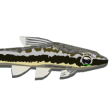Off topic, (1) for lack of a better place to put it, and (2) because the value of this might be total mulm (substitute less polite word meaning similar material), below is a diagram which I've adapted from the Sarmento-Soares et al (2006) paper to imagine what
might look like. I've been struggling to find a photo or illustration of
M. ater (we have none, and the original description by Ahl (1936) lacked a picture). So I lifted one of the diagrams from the 2006 paper, modified certain body proportions to match those dimensions listed by Ahl and modified the color scheme to fit Ahl's description.

Ahl, 1936 wrote:Beschreibungen dreier neuer Welse aus Brasilien.
Von Ernst Ahl.
(Zoologisches Museum Berlin.)
Eingeg. 14. Juli 1936.
Die nachstehend als neu beschriebenen Welse befanden sieh unter Sendungen, die dem Zoologischen Museum Berlin von den Herren ARNOLD, Hamburg, und SCHOLZE und POETZSCHKE, Berlin, zur Bestimmung zugesandt worden sind. Ich möchte nicht versäumen, auch an dieser Stelle den genannten Herren für das schöne übersandte Material bestens zu danken.
Microgianis ater sp. nov.
Körperhöhe 32/3 mal in der Körperlänge, Kopflänge 31/2 mal. Kopf etwas breiter als lang, flach; Schnauze abgerundet; Auge 32/3 mal in der Schnauzenlänge, 71/2 mal in der Kopflänge, 31/2 mal in der Interorbitalbreite; Maxillarbartel so lang wie der Mentalbartel, nicht bis zum Anfang des Pectoralstachels reichend; Postmentalbartel noch kürzer; Maul breit, der Winkel vor dem Auge; beide Kiefer vorne gleich lang; vordere Nasenlöcher deutlich tubulär; Zahngruppen des Prämaxillare ohne rückwärts vorspringende Winkel. Dorsale I 6, ihr Abstand von der Schnauzenspitze 23/5 mal in der Körperlänge; der Stachel etwas über 1/2 der Kopflänge. Anale 14, abgerundet. Basis der Dorsalen, Analen und Fettflosse etwa gleich lang. Pectoralstachel stark, mit großen Zähnen entlang dem ganzen Rande an beiden Seiten, die der Innenseite bedeutend größer als die der Außenseite; die Zähne des äußeren Randes nach hinten, die des inneren Randes nach vorne gebogen. Ventralen direkt hinter dem letzten Strahl der Dorsalen, gerade den Anfang der Analen erreichend. Caudale nicht sehr tief gegabelt, der untere Lappen etwas größer und länger als der obere, etwas kürzer als der Kopf.
Grundfärbung (in Alkohol) schwarz, Bauch grauweiß; ein sehr undeutliches, eben nur angedeutetes, wenig helleres Band über den Nacken von Pectorale zu Pectorale, ein ebensolches, ebenfalls nur schwach angedeutetes Band hinter der Dorsalen; ein heller Fleck vor der Fettflosse in der Mitte des Rückens. Alle Flossen schwarz, die Dorsale mit einem weißen Fleck in ihrer Mitte nahe dem hinteren Rande, die Caudale mit breiter, weißer Querbinde in der Mitte und mit weißem Endsaum.
Totallänge 81 mm.
Mittelbrazilien.
Ein Exemplar. 81 mm Totallänge, von Mittelbrasilien (JOH. PAUL ARNOLD, Hamburg. G.; die neue Art unterscheidet sich von den wenigen bekannten Arten der Gattung auffällig durch die höhere Anzahl der Strahlen in der Analen (14 gegenüber 9-11) und durch die Färbung.
Ahl, 1936 wrote:Descriptions of three new catfish from Brazil.
By Ernst Ahl.
(Zoological Museum Berlin.)
entered July 14, 1936.
The catfish described below as new were among the consignments sent to the Zoological Museum Berlin by Messrs. ARNOLD, Hamburg, and SCHOLZE and POETZSCHKE, Berlin, for identification. At this point I would like to thank the gentlemen mentioned very much for the beautiful material they sent.
Microglanis ater spec. nov.
Body height 32/3 times the body length, head length 31/2 times. Head slightly wider than long, flat; Rounded snout; Eye 32/3 times the length of the snout, 71/2 times the length of the head, 31/2 times the interorbital width; Maxillary barbel as long as the mental barbel, not reaching to the beginning of the pectoral spine; Postmental barbel even shorter; Mouth wide, the corner in front of the eye; both front jaws of equal length; anterior nostrils clearly tubular; Groups of premaxillary teeth without backward protruding angles.
Dorsal I 6, its distance from the tip of the snout 23/5 times the length of the body; the spine a little over 1/2 the length of the head. Anal 14, rounded. Base of the dorsal, anal and adipose fin about the same length. Pectoral spine strong, with large serrations <Zähnen> all along the margin on both sides, those on the inside considerably larger than those on the outside; the serrations <Zähnen> of the outer edge bent backwards, those of the inner edge bent forward. Ventral just behind the last ray of the dorsal, just reaching the beginning of the anal. Caudal not forked very deeply, the lower lobe slightly larger and longer than the upper, slightly shorter than the head.
Basic color (in alcohol) black, belly gray-white; a very indistinct, barely visible <eben nur angedeutetes>, slightly lighter band over the neck from pectoral to pectoral, a similar, also only weakly indicated band behind the dorsal; a light spot in front of the adipose fin in the middle of the back. All fins are black, the dorsal with a white spot in the middle near the posterior margin, the caudal with a wide, white transverse band in the middle and a white border.
Total length 81 mm.
Central Brazil.
One example, 81 mm total length, from Central Brazil (JOH. PAUL ARNOLD, Hamburg. G.); the new species differs from the few known species of the genus conspicuously in the higher number of rays in the anal (14 compared to 9-11) and in the color.
What I've done here, based on the body proportions, is used a 2006 schematic of
and altered the color pattern to match Ahl, then made the following body modifications (by estimates):
- Altered dorsal spine length
- Reduced indentation of caudal fin margin
- Filled in complete vertical dark bar on caudal fin
- Original M. nigripinnis diagram (Sarmento-Soares et al., 2006):

- My imagination of M. ater, based on Ahl, 1936:
It is but coincidence that I selected M. nigripinnis as the diagram on which to base my drawing, but fortune shined upon me. After creating my drawing, I happened to look at the original description of
M. nigripinnis, and there I found this:
Bizerril & Perez-Neto, 1992 wrote:A new pimelodid catfish of the genus Microglanis, collected in a stream at the State of Rio de Janeiro, Brazil, is described. It is similar to M. ater, from Central Brazil, differing mainly in having less anal fin rays and a longer dorsal spine. Ecological notes are included.
Similar to M. ater from central Brazil. Both forms are easily distinguished from all other Microglanis species by their colour pattern, with most of the body black, except for two paler bands, and with the pectoral, ventral, anal, adipose and dorsal fins almost completely black. The new species differs from M. ater mainly in the number of anal fin rays (12 vs 15) and in having a longer dorsal spine (1.52 to 1.75 vs 2.4 in predorsal length).
I did not attempt to alter then number of anal fin rays (since they are not accurately marked in the original
M. nigripinnis drawing anyway). But otherwise, this was the best drawing to start with... Who knew? God's grace was with me in figure selection, I guess.

Cheers, Eric




















